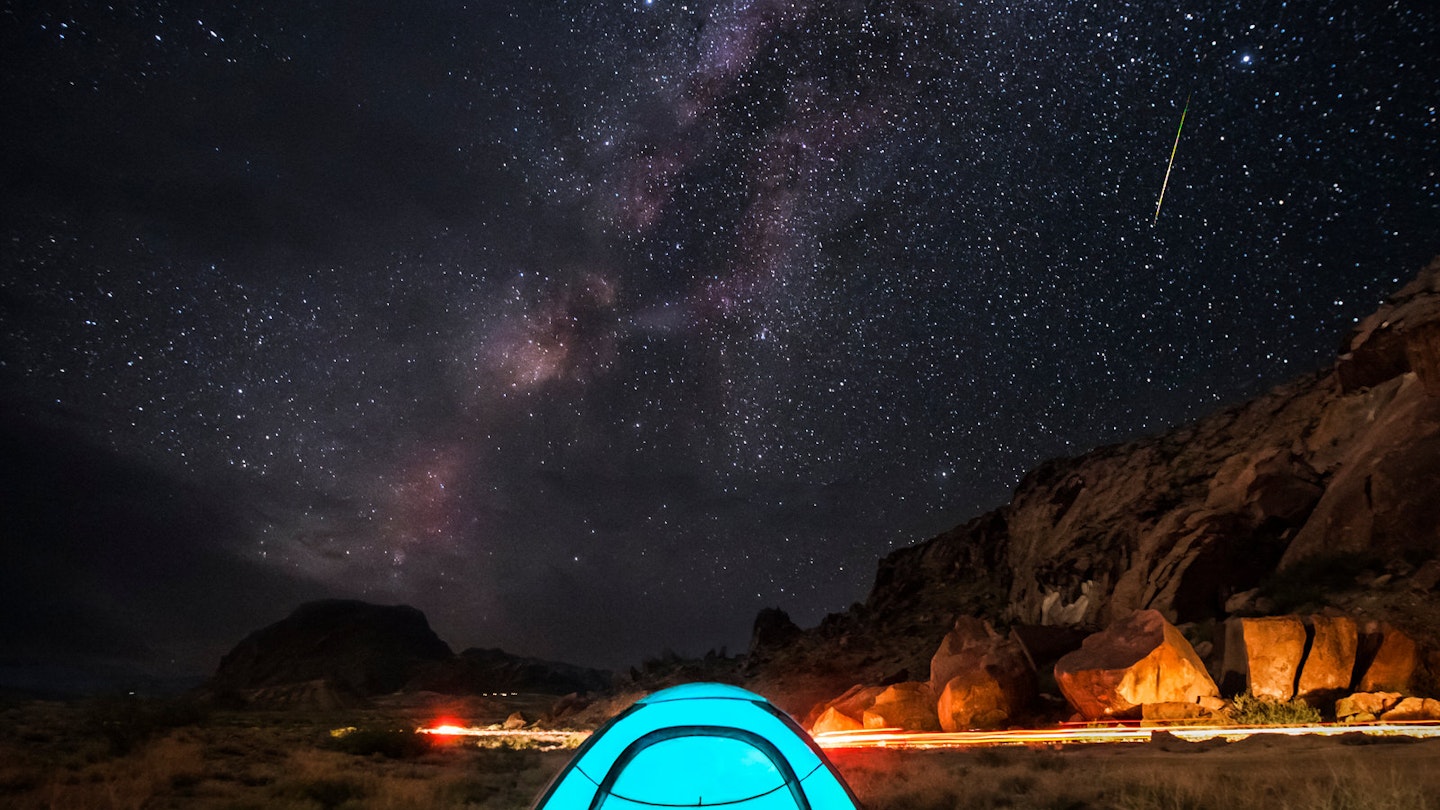Stargazing in the Southwest USA
The deserts and wide open spaces of the Southwest USA are among the darkest places in America and offer some of the country’s best possibilities for seeing the Milky Way in all its glory. The arid climate is reliably clear in this part of the world, so the sky is mercifully cloud-free most nights, perfect for stargazing into the heavens. Whether you have the constellations memorized or just enjoy the faint glow of starlight on your face, the Southwest USA offers something for all types of astronomers.
Big Bend National Park
Far, far away from pretty much everything, Big Bend can claim the least light-polluted skies of any national park in the lower 48 states. If you look at Big Bend on a map, the Mexican-border-hugging park carves a loop through far southwest Texas, and there are pretty much no major settlements anywhere near it on either side of the border. To boot, the park has re-lamped external lighting with LED bulbs at its buildings and parking areas to reduce light pollution.

Big Bend is huge, and almost anywhere you go inside the park will prove excellent for stargazing (they suggest you can see around 2000 stars on an average evening here). Experienced desert hikers and campers should head out onto any of the park’s trails for an overnight excursion (take plenty of food and water; it’s hot and remote), but if you are less outdoorsy, somewhere like the Rio Grande Village Nature Trail is extremely accessible on paved paths and has incredible vistas even after dark. There is an accompanying campsite here.
A bit farther north from the park, the McDonald Observatory in Fort Davis hosts star parties three times a week that are preceded by a ‘Twilight Program’ where you learn about the night sky, eclipses, the moon, and our solar system’s planets using models and demonstrations.
Grand Canyon Star Parties
Grand Canyon National Park covers nearly 2000 square miles in northern Arizona, most of it perfect for stargazing thanks to a lack of ambient light for literally miles around. Adding to that is the natural romance of stargazing here: your view shifting from one of Earth’s greatest natural wonders to the pure awe of the vast cosmos. Yavapai Point and Lipan Point, both on the South Rim, are easily accessible spots with wide, clear views of the Milky Way.
Stargazing is easy here at all times of year, whether blanketed underfoot by a light layer of winter powder or camping out on a balmy summer’s eve. Every year, the park hosts its annual star party (often in June), when stargazers gather for a week of astronomical events; talks from professional astronomers, telescope viewings, constellation tours, and more are hosted each evening.
Cosmic Campground
The Cosmic Campground in remote southwestern New Mexico was designed specifically for stargazing. Set within the wild and rugged Gila National Forest, the campground was designated as an International Dark Sky Sanctuary in 2016 for its incredible clear skies year-round. Rules at the campground prohibit light pollution: artificial lights are banned after sundown and flashlights must be covered with red plastic. Real astronomy buffs can bring telescopes to set up on dedicated concrete platforms, but the sky here is so starry that you can sit mesmerized for hours with just the naked eye.
Lowell Observatory
See the stars through the famed telescope that first spotted Pluto at the Lowell Observatory. Located in Flagstaff, Arizona – itself a designated International Dark Sky City – the 120-year-old observatory runs nightly astronomy programs that allow you to explore the cosmos through its collection of telescopes, including the 1894 Clark Refracting Telescope through which astronomer Percival Lowell discovered Pluto in 1930.
Flagstaff’s Dark Skies Coalition also organizes regular star parties in Buffalo Park that take advantage of the city’s dark-sky-friendly lighting codes to view the heavens.
Great Sand Dunes
Giant sand dunes along America’s highest mountain range – Great Sand Dunes National Park is already an enigma, and seeing this odd Rocky Mountains-meets-dunes landscape by night only heightens the mystery. To boot, the tallest sand dune here (and in the country) is the perfectly-named, 750-foot-high Star Dune.
Exploring the dunes by night is utterly magical but can be disorienting, so this is a place to be careful and come armed with a red flashlight. Camping is permitted anywhere inside the 30-square-mile dunefield, meaning you can pitch your tent at the darkest dunetop you can find, so long as the weather and wind conditions are friendly.
The park puts on regular evening programs usually aimed at discovering local nocturnal wildlife or nighttime survival skills, as well as moonlit hikes up the dunes.
Natural Bridges National Monument
In 2007, Natural Bridges became the world’s first designated dark-sky park. Remote southeastern Utah is not a surprising place to find dark skies, but it remains one of the Southwest’s most magical places for stargazing, particularly because the unique geological features that give the park its name – sandstone rock bridges formed over thousands of years by ancient stream erosion – provide natural frames through which to view the sky.
There are 13 dry campsites within the park for overnight stays. If camping doesn’t appeal, the tiny town of Bluff is about an hour’s drive away and boasts some fine accommodation, as well as stargazing spots along the soothing San Juan River.
Very Large Array
Not technically a stargazing spot (though the night skies here are undoubtedly beautiful), astronomy buffs won’t want to miss a visit to the Very Large Array (VLA) in central New Mexico. One of the most important astronomical research centers in the country, the VLA is a collection of 27 satellite dishes that are constantly at work searching for radio waves from the outer reaches of the universe.
A self-guided walking tour allows you to get up close with the dishes and their unique railway-track movement system, and also see where Jodie Foster listened for extraterrestrial life in the popular astronomy movie Contact.





